Since the beginning of the 1990s, Russia has been suffering from a negative demographic trend. Despite active immigration—more than 9 million people arrived in Russia between 1990 and 2014—the population declined by 3.7 million (Chart 1). [1] Though many developed countries face a similar challenge, there are a number of specific behind the trend Russia: decline in the quality of life in the first decade after the disintegration of the USSR, rising mortality among men below 50 years old due to alcoholism, the decline in the number of women aged between 20 and 30 years old because of the demographic pyramid that was damaged during World War II. [2]
Chart 1. Changes in the Population of Russia by Factors (1990-2014)
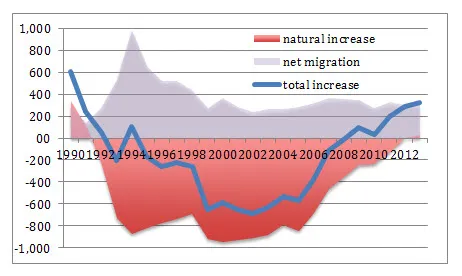
The problem of declining population in Russia was identified by Russian and international experts long ago and all forecasts gave a negative prognosis: the decline of population will continue and even accelerate starting 2015. By 2005, this challenge had been recognized by Russian authorities and steps were taken to mitigate the problem. Measures were adopted to increase the birth rate, reduce mortality, as well as to increase healthcare protection reduce smoking and alcoholism.
At first glance, those measures had a positive impact: the negative rate of natural increase (RNI) of population shrank to zero by the end-2012 and even turned positive in 2013-2014. But many experts believe that it is too early to celebrate. Such positive changes could be attributed to changes in the family model: Today, Russian women are having their first child later in life (in 1999 the modal age of the first birth was 21 years, in 2012, it was 25 years; thus a lower birth rate five years ago is being compensated now), as well as to favorable demographics (the current number of Russian women in the age group 25-30, those with the highest fertility rates, is historically high, 20 percent more than it was 10 years ago and 80 percent more than it will be in 10 years). The payoff from both factors will be exhausted in the next year or two; only then can the real efficiency of the government’s measures be evaluated.
At the end of 2014, the Russian statistical agency Rosstat published its updated demographic forecast through 2050. The forecast confirms that demographics will remain the biggest political, social, and economic challenge for Russia in the coming decades. Moreover, contrary to earlier estimates, the situation will not stabilize by 2030-2035.
Three scenarios, all migration-based
Three scenarios were provided in the forecast (Chart 2): i) a continuation of current trends (low), ii) a more realistic appraisal of the effectiveness of the measures taken to date (medium), and iii) an outcome reflective of the goal Russian demographic policy to 2025, the authorities’ dream scenario (high). The first scenario suggests Russia’s population will shrink by 20 percent over the next 35 years; the second that it will remain at the current level; and the third that the population will increase by 15 percent. In these three scenarios, Rosstat used not only a different demographic hypothesis, but different migration assumptions. The first scenario assumes that annual inward immigration over the forecast period will gradually decline from 270,000 people a year at the start of the period to 170,000 by the end. In total, Russia’s population will grow by 7.7 million people in the next 35 years due to immigration. In the “current-level” scenario, the annual immigration gain increases to 385,000 people by 2030 and then gradually grows to 400,000 per year. This results in an additional 13.6 million people over the period. In the “dream” scenario, annual immigration increases rapidly up to half-a-million people a year by 2022, and then to 555,000 by 2030, holding at that level until 2050. This would mean almost 19 million more people from immigration.
Chart 2. Population of Russia: Three Scenarios
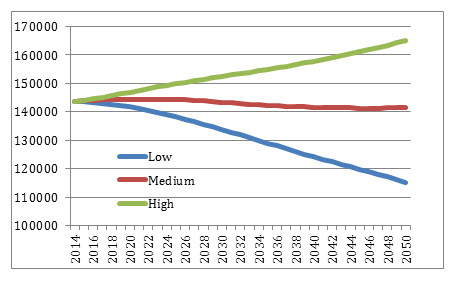
Are there so many potential migrants?
It seems that neither the high migration variant projection, nor the “current-level” projection, are very realistic. According to the Federal Migration Service of Russia, today there are about 11 million foreign citizens in Russia, 80 percent of whom are citizens of the countries comprising the Commonwealth of Independent States (CIS) (Table 1). This reflects the main requirement for massive foreign labor in Russia, knowledge of the Russian language.
To reach the levels forecast in the latter two scenarios, provided that the CIS countries will continue to supply 80 percent of immigrants, the number of citizens of those countries living in Russia should increase by 2.5 and 3.2 times, respectively. That is hard to believe, since the potential of attracting additional migrants from the two major sources—Ukraine and Uzbekistan—seems to have been exhausted.
After the annexation of Crimea and the conflict in the eastern Ukraine, political relations between Russia and Ukraine are seriously damaged. In the coming decades Ukraine itself will pass through similar demographic processes as Russia, and its potential as a supplier of labor will decline. In addition, with Ukraine increasingly integrating with Europe, Ukrainian labor will be more inclined to look to the countries of Eastern Europe as destinations for pursuing employment opportunities.
Table 1. CIS Citizens Living in Russia as % of the Population of the Country
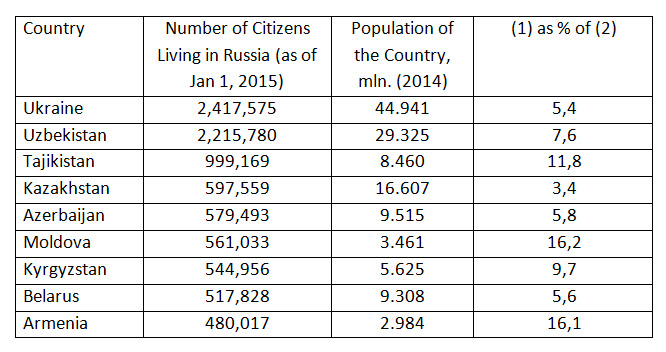
Source: Federal Migration Service of Russia; www.worldometers.info
Meanwhile, Uzbekistan is itself entering a period of rapid demographic change, with reduced fertility and a sharp decline in population growth that will limit its capabilities for the export of labor. Moreover, if Uzbekistan continues to benefit from its natural resources and closer ties to China its own labor needs may compete with Russia’s. Gradually, the main marginal supplier of migrants in Russia will be Tajikistan, but its resources should not be exaggerated—today, every second Tajik male of working age lives in Russia, while the overall increase of the population of the country by 2050 will be about 7 million people. This means that Russia needs to seek migration from China, Vietnam and, possibly, India, Pakistan, and Bangladesh.
Such a significant increase in the number of foreigners in Russia will inevitably lead to growing social pressure in the country, given the relatively nationalistic tone in official Russian rhetoric in recent years. According to Levada-center polls, more than 75 percent of Russians support the introduction of migration limits (up from less than 50 percent in 2002) while the number of those who believe migration may benefit Russia has declined from 44 percent to 16 percent [3].
Decline in labor force quality
The forecast also provides an estimate for labor-force growth (population of the working age), which is important for assessing the long-term economic prospects of the country. Here, the forecast looks even worse, because the share of Russia’s working age population is declining by about the same magnitude in all scenarios—from 60 percent to less than 50 percent. This decline takes place in two waves: an initial labor force decline by 8-12 percent (medium and low scenarios) between 2015 and 2020, and then by another 10-20 percent after 2030 (Chart 3).
Chart 3. Working Age Population of Russia: Three Scenarios
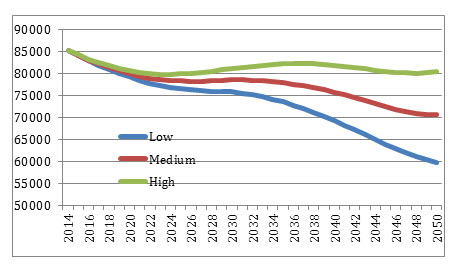
But, again, it is important not to forget about the migration effect. Rosstat does not provide such data in its forecast, but if we use the actual share of the working age population in the total number of migrants from CIS countries (90 percent) the result is predictable—in the more optimistic scenario the number of working age population is higher, but so too is Russia’s dependence on labor migrants.
Because of the growing share of migrants in the working age population in any scenario, the Russian economy will be faced with a rapid decline in the average quality of the labor force (measured by education and professional skills). Russia is unlikely to invest in education systems in neighbor countries while they themselves have no resources for such investment.
Pressure on the pension system
These demographic forecasts also provide a good indication of the challenges that will face the Russian pension system. The chart below shows the dynamics of the upcoming changes in the ratio of those who pay pension contributions to the pension system (people of working age [4]) and those who receive pensions. In various scenarios, this ratio decreases equally from the level of 2.5 today to around 2 by 2022, where it should remain for about 10 years, before dropping further to about 1.6 by 2045 (Chart 4).[5]
Chart 4. Working Age to Above Working Age Population Ratio in Russia: Three Scenarios
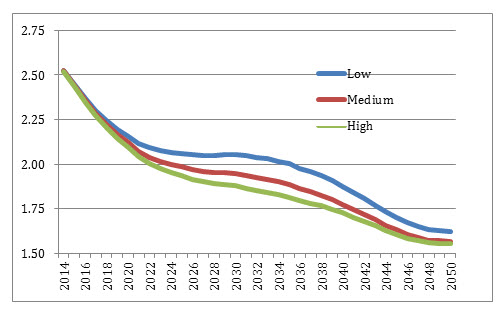
This data shows that the expenditure pressure of the distribution pension system will increase and will require Russian authorities to accept either an increase in payroll taxes, an increase in federal subsidies to the pension fund, an increase in the retirement age, or a decrease in the real size of pensions, or some combination of all of these measures.
As with many economic processes, it is not possible to change direction or speed overnight. Demography is one of the most inertial factors—the number of people born in a certain period cannot increase during the life of the generation—that makes demographic forecasts more reliable than any others. Rosstat’s forecasts demonstrate that, regardless of who leads the country, Russian economic policy will face the very serious threat of rapid depopulation in the coming decades. To maintain the current population of the country (the “current-level” scenario), Russia needs to encourage a large-scale immigration influx, more than 12 percent of the current population. But even this will not entirely offset a rapidly ageing population and growing fiscal pressure on the pension system. All that will make the Russian economy less competitive and less attractive, and if Russia continues to follow an isolationist policy, it may face its own, labor-based, secular stagnation.
[1] This ratio in reality is a little lower: 15-16 percent of working age people are not employed in the economy.
[2] During World War II, the Soviet Union lost 26.6 million people—13.7 percent of the population—while a decline in fertility during the war demographic may led to further losses of 8-10 million. Despite 70 years having passed since the war, this damage to the demographic pyramid has not been repaired.
[3] “Public Opinion-2014” (in Russian)- Levada-Center, 2014, table 19.8
[4] This ratio in reality is a little lower: 15-16 percent of working age people are not employed in the economy.
[5] It is worth noting that this ratio (2.6 or 1.6, for example) is not absolutely correct as Rosstat includes labor migrants in the overall labor force while significant number of foreigners are not contributors to the Pension system.



Commentary
The Russian economy in 2050: Heading for labor-based stagnation
April 2, 2015